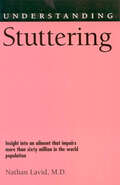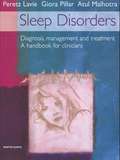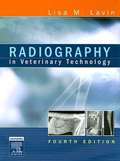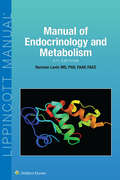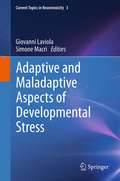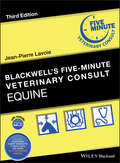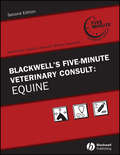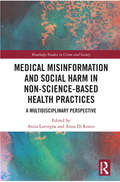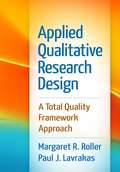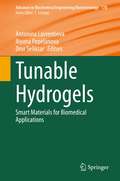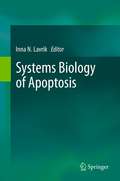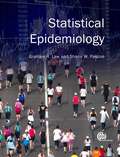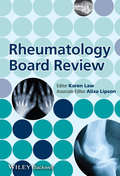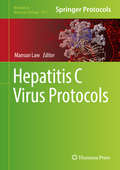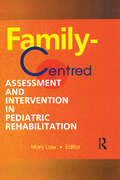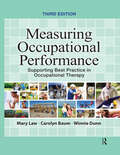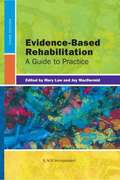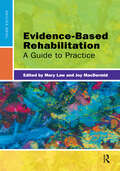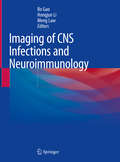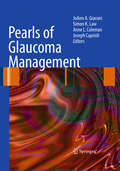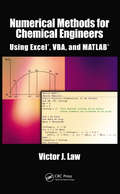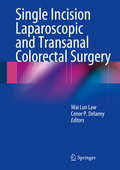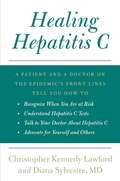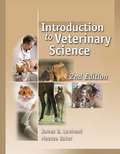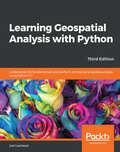- Table View
- List View
Understanding Stuttering (Understanding Health and Sickness Series)
by Nathan Lavid M.D.Stuttering is an affliction that affects every ethnicity and every culture equally, some sixty million people worldwide. Five percent of children stutter. Typically, this debilitating condition emerges when a child is between the ages of two and six. Twenty percent of these children will continue to stutter as adults. Although it is so pervasive, there is great misunderstanding about stuttering. Socially isolating the people it strikes, the disorder prevents them from the kind of candid discussions that would help them gain an understanding of it. In turn, social isolation creates misconceptions. In Understanding Stuttering a writer, who is both a practicing physician and former researcher on stuttering, examines the medical roots of the problem and, hoping to bring alleviation, shares his findings. He defines stuttering as a medical condition that is neurologically based or inherited. In clear language he explains the basics of brain anatomy and function, tells of the latest scientific advances in diagnosis and treatment of stuttering, and explains the difference in acquired stuttering and Tourette syndrome. Using examples from his practice, he details effective treatments, including speech therapy and medications. He discusses the most promising new research and tells how the findings of this research will improve treatments and provide a possible cure. Understanding Stuttering concludes with practical tips on how to converse with those who stutter and lists organizations that provide additional information and support.
Sleep Disorders Handbook: A Handbook for Clinicians
by Peretz Lavie Giora Pillar Atul MalhotraRecent years have seen the rapid development of sleep medicine as a new medical subspecialty. It is estimated that at least 30% of the adult population suffer at least once from some sort of sleep disturbance. Patients with sleep disorders are frequently among the most difficult to treat and account for a high percentage of absenteeism in the workp
Radiography in Veterinary Technology 4th Ed
by Lisa M. LavinWritten by a veterinary technician for veterinary technicians, students, and veterinary practice application, this concise, step-by-step text will help users consistently produce excellent radiographic images. It covers the physics of radiography, the origin of film artifacts, and positioning and restraint of small, large, avian, and exotic animals. It discusses everything from patient preparation, handling, and positioning to technical evaluation of the finished product.
Manual of Endocrinology and Metabolism (Lippincott Manual Series)
by Norman LavinIdeal for all health care professionals who evaluate, diagnose, treat, or refer patients with endocrine disease or disorders, Manual of Endocrinology and Metabolism, Fifth Edition, brings together nearly 150 global authorities who share their knowledge and expertise on endocrine disorders in children, adolescents, and adults. Using a concise outline format, this thoroughly updated manual presents clinical information and protocols needed in everyday practice, with an emphasis on diagnosis and treatment. Succinct chapters and an abundance of tables and diagrams make complex information easy to find and understand.
Adaptive and Maladaptive Aspects of Developmental Stress (Current Topics in Neurotoxicity #3)
by Giovanni Laviola Simone MacrìSince the very early stages of life, we all experience some form of stress. Stressors can be mild to severe and can range from unsuccessfully longing for maternal milk in infancy, to recklessly wiggling on a motorbike to be on time to watch the NBA finals on TV, to breaking up a relationship. All those events that we call "stress" have the capability of perturbing a given state of psychological and physiological equilibrium and moving it to a different level. The transition from crawling to walking has to be considered a form of stress as much as losing a job. It is through a continuous cross-talk between environmental stressors and individual adaptations that we build our personalities and our ways to cope with daily hassles. External challenges should not necessarily be regarded as "bad", but instead seen as constructive forces forming our ability to navigate a changing world. What is stress good for? What is stress bad for? When and why do we need to be "stressed"? Should we worry about stress? When does stress equate to "normality"? When does it turn into pathology? We hope with this book to provide some answers to these fundamental questions.
Blackwell's Five-Minute Veterinary Consult: Equine (Blackwell's Five-Minute Veterinary Consult)
by Jean-Pierre LavoieWritten by today's leading experts, this book keeps practitioners completely current with the latest in disease management of horses, taking a clear and practical approach ideal for daily equine practice. Arranged by subject for efficient searching, each topic covers clinical signs, diagnosis, treatment, and follow-up. Practitioners gain quick access to information about conditions and disorders encompassing behavior, cardiology, dermatology, endocrinology, gastroenterology, hematology, infectious diseases, laboratory tests, musculoskeletal, neonatology, neurology, ophthalmology, respiratory, theriogenology, toxicology, and urinary diseases. Blackwell's Five-Minute Veterinary Consult: Equine, Third Edition enhances the practitioner's skills in evidence-based treatment planning, and is unmatched for its comprehensive coverage of more than 500 diseases and conditions. This handy, practical guide will help cut down on time spent navigating through other resources, so that equine veterinarians and veterinary students can study, diagnose, and treat with greater efficacy. Key Features The premier all-in-one equine resource designed specifically for quick information retrieval Divided into identically formatted topics for easy searching by alphabetical listing or by body system Coverage of more than 500 diseases and conditions Fast access to the accumulated wisdom of hundreds of veterinary experts Includes a companion website with 43 editable client handouts, 3 video clips, 8 color images, and select further reading
Blackwell's Five-Minute Veterinary Consult: Equine (Blackwell's Five-minute Veterinary Consult Ser.)
by Jean-Pierre Lavoie Kenneth William HinchcliffBlackwell’s Five-Minute Veterinary Consult: Equine, Second Edition is a concise, comprehensive resource for all topics related to equine medicine. Now fully revised and updated, this authoritative quick reference provides thorough coverage of practical information, arranged alphabetically for efficient searching. Bringing together the expert knowledge of 175 contributors, the popular Five-Minute Veterinary Consult format allows rapid access to complete coverage of nearly 500 diseases and conditions seen in the horse. This reference is an essential tool for students and practicing veterinarians to quickly diagnose and treat equine patients.
Medical Misinformation and Social Harm in Non-Science Based Health Practices: A Multidisciplinary Perspective (Routledge Studies in Crime and Society)
by Anita Lavorgna Anna Di RoncoFraudulent, harmful, or at best useless pharmaceutical and therapeutic approaches developed outside science-based medicine have boomed in recent years, especially due to the commercialisation of cyberspace. The latter has played a fundamental role in the rise of false ‘health experts’, and in the creation of filter bubbles and echo chambers that have contributed to the formation of highly polarised debates on non-science-based health practices—online as well as offline. By adopting a multidisciplinary approach, this edited book brings together contributions of international academics and practitioners from criminology, digital sociology, health psychology, medicine, law, physics, and journalism, where they critically analyse different types of non-science-based health approaches. With this volume, we aim to reconcile different scientific understandings of these practices, synthesising a variety of empirical, theoretical and interpretative approaches, and exploring the challenges, implications and potential remedies to the spread of dangerous and misleading health information. This edited book will offer some food for thought not only to students and academics in the social sciences, health psychology and medicine among other disciplines, but also to medical practitioners, science journalists, debunkers, policy makers and the general public, as they might all benefit from a greater awareness and critical knowledge of the harms caused by non-scientific health practices.
Applied Qualitative Research Design
by Paul J. Lavrakas Margaret R. RollerThis unique text provides a comprehensive framework for creating, managing, and interpreting qualitative research studies that yield valid and useful information. Examples of studies from a wide range of disciplines illustrate the strengths, limitations, and applications of the primary qualitative methods: in-depth interviews, focus group discussions, ethnography, content analysis, and case study and narrative research. Following a consistent format, chapters show students and researchers how to implement each method within a paradigm-neutral and flexible Total Quality Framework (TQF) comprising four interrelated components: Credibility, Analyzability, Transparency, and Usefulness. Unlike other texts that relegate quality issues to one or two chapters, detailed discussions of such crucial topics as construct validity, interresearcher reliability, researcher bias, and verification strategies are featured throughout. The book also addresses applications of the TQF to the writing, review, and evaluation of qualitative research proposals and manuscripts. Pedagogical Features: *Summary tables that highlight important content, such as the application of a method to vulnerable or hard-to-reach populations. *Case studies that illustrate TQF standards in practice for each method. *Guidelines for effective documentation (via thick descriptions) of each type of study. *End-of-chapter discussion topics, exercises, and suggested further reading and Web resources. *Chapters open with a preview and close with a bulleted summary of key ideas. *Extensive glossary.
Tunable Hydrogels: Smart Materials for Biomedical Applications (Advances in Biochemical Engineering/Biotechnology #178)
by Antonina Lavrentieva Iliyana Pepelanova Dror SeliktarThis book reviews the current knowledge on tunable hydrogels, including the range of different materials and applications, as well as the existing challenges and limitations in the field. It covers various aspects of the material design, particularly highlighting biological responsiveness, degradability and responsiveness to external stimuli. In this book, readers will discover original research data and state-of-the-art reviews in the area of hydrogel technology, with a specific focus on biotechnology and medicine. Written by leading experts, the contributions outline strategies for designing tunable hydrogels and offer a detailed evaluation of the physical and synthetic methods currently employed to achieve specific hydrogel properties and responsiveness. This highly informative book provides important theoretical and practical insights for scholars and researchers working with hydrogels for biomedical and biotechnological applications.
Systems Biology of Apoptosis
by Inna N. LavrikSystems Biology of Apoptosis summarizes all current achievements in this emerging field. Apoptosis is a process common to all multicellular organisms. Apoptosis leads to the elimination of cells via a complex but highly defined cellular programme. Defects in the regulation of apoptosis result in serious diseases such as cancer, autoimmunity, AIDS and neurodegeneration. Recently, a substantial step forward in understanding the complex apoptotic pathways has been made by utilising systems biology approaches. Systems biology combines rigorous mathematical modelling with experimental approaches in a closed loop cycle for advancing our knowledge about complex biological processes. In this book, the editor describes the contemporary systems biology studies devoted to apoptotic signaling and focuses on the question how systems biology helps to understand life/death decisions made in the cell and to develop new approaches to rational treatment strategies.
Statistical Epidemiology
by Graham Law Shane PascoeStatistics are a vital skill for epidemiologists and form an essential part of clinical medicine and public health. This textbook introduces students to statistical epidemiology methods in a carefully structured and accessible format. With clearly defined learning outcomes, the suggested chapter orders can be tailored to the needs of students at both undergraduate and graduate level from a range of academic backgrounds. The book covers study design, measuring disease, bias, error, analysis and modelling and is illustrated with figures, focus boxes, study questions and examples applicable to everyday clinical problems. Drawing on the authors' extensive teaching experience, the text provides an introduction to core statistical epidemiology that will be a valuable resource for students and lecturers in health and medical sciences and applied statistics, health staff, clinical researchers and data managers.
Rheumatology Board Review
by Karen Law Aliza LipsonThe field encompassed by rheumatology has evolved rapidly over the last decade to include multiple immune-modulating and biologic medications, new classification criteria, significant updates on bone metabolism, and completely new paradigms of treatment based on groundbreaking studies published within the last 5 years. Although much has been adopted as standard of care based on new data, most textbooks do not reflect these practice changes.Rheumatology Board Review highlights the latest advances in the field and new standards of care, including references to current citations in the medical literature. It provides international standards and guidelines and is designed to convey a maximum amount of information quickly and efficiently, with many helpful schematics, radiographs, and tables.Rheumatology Board Review offers chapter coverage of:* Non-inflammatory joint and soft tissue disorders* Selected topics in rheumatoid arthritis* Selected topics in systemic lupus erythematosus* Antiphospholipid antibody syndrome* IgG4-related disease* Myopathies* Selected topics in pediatric rheumatology* HIV and rheumatic diseases* Miscellaneous arthropathies* Osteoporosis* Review of musculoskeletal radiology* Study design, measurement, and basic statistical analysis* Update on vasculitisRheumatology Board Review is a must-have reference for rheumatology fellows and professionals seeking a concise yet thorough review of state-of-the-art rheumatology.
Hepatitis C Virus Protocols (Methods in Molecular Biology #1911)
by Mansun LawThis volume details the most updated concepts and experimental protocols developed by leading researchers in the field. Chapters guide readers through methods on bioinformatics tools, hepatitis c virus(HCV) cloning, culture, and purification, HCV life cycle, host immune responses, and small animal models. Written in the highly successful Methods in Molecular Biology series format, chapters include introductions to their respective topics, lists of the necessary materials and reagents, step-by-step, readily reproducible laboratory protocols, and tips on troubleshooting and avoiding known pitfalls.Authoritative and cutting-edge, Hepatitis C Virus Protocols aims to ensure successful results in the further study of this vital field.
Family-Centred Assessment and Intervention in Pediatric Rehabilitation
by Mary LawFamily-Centred Assessment and Intervention in Pediatric Rehabilitation analyzes the effectiveness of Family-Centred Services (FCS) for children with disabilities or chronic illnesses. This text provides you with the exact definition of FCS and offers proof that parent involvement in children's treatment greatly enhances therapy. You can use the suggestions and methods to integrate parents into therapy, maximizing the family's intervention experiences and making your work more successful and effective.Many clinicians agree that families play a crucial part in deciding what intervention strategies are best for their children. From this text, you will learn that listening to parents and valuing parental input will give you insight into the goals, needs, and ambitions families have for their children. This enables you to choose, with the parent, the interventions that best suit your patients’needs and the needs of their families. In addition to information on how to integrate parents and families into intervention, Family-Centred Assessment and Intervention in Pediatric Rehabilitation offers suggestions that will improve your existing FCS or help you implement a family- centred approach, including:performing therapy in natural settings, such as school or home, to make changes in the children's social and physical environmentsacknowledging the grieving and adaptation process of families while being compassionate and understandingletting parents describe what they would like their child to be able to do and accomplish in the future putting the parents’concerns and requests first, enabling parents to deal with caring for their child supporting parents and reinforcing them when they have innovative and helpful ideasinforming parents on the progress of their children and educating parents on methodologies and strategies used in FCSMany of the suggestions derived from the analysis of current data and original research in Family-Centred Assessment and Intervention in Pediatric Rehabilitation have immediate clinical applicability, allowing you to quickly adapt methods into your intervention processes. This text also provides you with information on types of evaluative methods, such as Measure of Processes of Care (MPOC) and Family-Centred Program Rating Scale (Fam PRS), that will help you determine if your FCS program is working efficiently. Emphasizing the goal of parent interaction in FCS services, Family-Centred Assessment and Intervention in Pediatric Rehabilitation offers methods that will improve your work with families and patients, making services more beneficial and relevant to the child and to their families.
Measuring Occupational Performance: Supporting Best Practice in Occupational Therapy
by Mary Law Winnie Dunn Carolyn M. BaumAs the profession of occupational therapy continues to mature and expand its practice, the measurement of occupational performance is one of the key avenues that all practicing clinicians will need to explore and master. Measuring Occupational Performance: Supporting Best Practice in Occupational Therapy, Third Edition summarizes the measurement tools needed to assess client occupational performance, to provide the best intervention, and to document the effectiveness of that intervention. These measurement tools are not just a compilation of all that are available for measurement relevant to occupational therapy; they are an elite group of tools carefully selected by the editors through a process of rigorous theoretical, clinical, and scientific reasoning. In this Third Edition, Drs. Mary Law, Carolyn Baum, and Winnie Dunn have updated current chapters and added new topics that have not been covered in past editions, such as a chapter on measuring school performance, a key area of practice. Also included is a chapter on measurement principles and development to highlight the concepts common to all the measures included in the text. The Third Edition also has a focus on the best measures and measures that are used most frequently.Features of the Third Edition:Offers insight into the importance of measuring functional performance, methodologies, measurement issues, and best approach for outcome measurement Conveys a broad focus on occupational performance and offers examples from a wide range of practice settings and from multiple spots throughout the lifespan Explains the technical aspects of measurement development and methodologies and which components of functioning are to be measured and how Develops an understanding of the theoretical aspects and evidence for both standardized tests and non-standardized tests Instructors in educational settings can visit www.efacultylounge.com for additional material to be used for teaching in the classroom.New in the Third Edition: Focus on strengths-based approaches Measures health and disability at both individual and population levels using the International Classification of Functioning, Disability and Health (ICF) An emphasis on evidence-based practice and using evidence from other disciplines, not just from occupational therapy New chapter focused on school-based practice New content on reliability, validity, and responsiveness New content on goal attainment Additional material on decision making in practice In this changing health care environment, Measuring Occupational Performance: Supporting Best Practice in Occupational Therapy, Third Edition explains how core values and beliefs can be put into everyday practice and is the essential reference manual for the evidence-based occupational therapy and occupational therapy assistant student and practitioner.
Evidence-based Rehabilitation: A Guide To Practice (Third Edition)
by Mary Law Joy MacDermidWhile evidence-based practice (EBP) has greatly influenced rehabilitation in the past decade, it continues to evolve and practitioners need guidance to implement evidence into their practice. Evidence-Based Rehabilitation: A Guide to Practice, the best-selling text providing step-by-step EBP guidance for rehabilitation professionals, has been updated into an expanded Third Edition. <p><p> In Evidence-Based Rehabilitation, Third Edition Drs. Mary Law and Joy MacDermid, along with their contributors, explain evidence-based rehabilitation, the concepts underlying EBP, and build the reader's knowledge and skills through specific learning. The text is organized by the steps of the EBP process--introduction to EBP, finding the evidence, assessing the evidence, and using the evidence. <p> EBP focuses first and foremost on making the best decisions for each client and using the best information available. For many rehabilitation practitioners, building skills in EBP is best done one step at a time. Evidence-Based Rehabilitation helps the rehabilitation student and practitioner develop his or her knowledge and skills to implement evidence-based rehabilitation in practice.
Evidence-Based Rehabilitation: A Guide to Practice
by Mary Law Joy MacDermidWhile evidence-based practice (EBP) has greatly influenced rehabilitation in the past decade, it continues to evolve and practitioners need guidance to implement evidence into their practice. Evidence-Based Rehabilitation: A Guide to Practice, the best-selling text providing step-by-step EBP guidance for rehabilitation professionals, has been updated into an expanded Third Edition.In Evidence-Based Rehabilitation, Third Edition Drs. Mary Law and Joy MacDermid, along with their contributors, explain evidence-based rehabilitation, the concepts underlying EBP, and build the reader’s knowledge and skills through specific learning. The text is organized by the steps of the EBP process—introduction to EBP, finding the evidence, assessing the evidence, and using the evidence.EBP focuses first and foremost on making the best decisions for each client and using the best information available. For many rehabilitation practitioners, building skills in EBP is best done one step at a time. Evidence-Based Rehabilitation helps the rehabilitation student and practitioner develop his or her knowledge and skills to implement evidence-based rehabilitation in practice. Benefits of the Third Edition:• All chapters have been updated with new information and resources• New chapters about systematic reviews, and knowledge transfer• Extensive guide available with specific student activities and answers for faculty use• Critical review forms included for student use—these forms have been used by practitioners and researchers around the world for 10 to 20 years• Recognition throughout the book that EBP in rehabilitation means bringing together research evidence, clinical reasoning of the therapist and client values and goals• Fits the standard 3-unit course design with 11 to 12 sessionsIncluded with the text are online supplemental materials for faculty use in the classroom.Designed and written by an occupational therapist and a physical therapist with extensive research, education, and practice experience, Evidence-Based Rehabilitation: A Guide to Practice, Third Edition will guide both occupational therapy and physical therapy students and practitioners as they incorporate evidence-based practice into their work.
Imaging of CNS Infections and Neuroimmunology
by Meng Law Bo Gao Hongjun LiThis book summarizes the imaging characteristics and theory of CNS infections, serving as a clinical guidance and having a practical significance for the understanding, prevention and diagnosis of infectious neurology. It includes extensive CT, MRI images on gross anatomy, pathological tissue, immunohistochemistry, electronic speculum, etc. It is divided into 19 chapters according to infectious types.On the basis of imaging diagnosis, through the cross research of imaging with autopsy and pathology, the imaging characteristics and evolution was revealed. This book will be a valuable reference on the clinical practice and research of neuroinfections.
Pearls of Glaucoma Management
by Simon K. Law Joann A. Giaconi Joseph Caprioli Anne L. ColemanThis concise and comprehensive guide is written by international experts of the field who are familiar with the world's literature. Based on the world's literature and their own experience, authors state and explain how they prefer to manage patients and problems clinically. Each chapter author gives the reader numerous clear and specific tips and pearls for the diagnosis and management of Glaucoma. The reader-friendly structure of this lavishly illustrated 4-colour book ensures that the necessary information is quickly found and remembered. This book ensures a pleasant learning experience on Glaucoma management with the goal of an improved treatment outcome.
Numerical Methods for Chemical Engineers Using Excel, VBA, and MATLAB
by Victor J. LawWhile teaching the Numerical Methods for Engineers course over the last 15 years, the author found a need for a new textbook, one that was less elementary, provided applications and problems better suited for chemical engineers, and contained instruction in Visual Basic for Applications (VBA). This led to six years of developing teaching notes that
Single Incision Laparoscopic and Transanal Colorectal Surgery
by Wai Lun Law Conor P. DelaneySingle Incision Laparoscopic and Transanal Colorectal Surgery provide a comprehensive and state-of-the art review of single incision laparoscopic and transanal colorectal surgery. The text concentrates on surgical techniques and tricks in single incision laparoscopic and transanal surgery with detailed descriptions of the techniques, as well as indications and limitations of the procedures. The newly available evidence on these procedures is emphasized and all procedures are richly illustrated with diagrams and photos. Written by experts in their fields, Single Incision Laparoscopic and Transanal Colorectal Surgery is valuable resource for general surgeons, colon and rectal surgeons, laparoscopic GI surgeons, surgical residents and fellows in training interested in these two rapidly developing fields in colorectal surgery.
Healing Hepatitis C
by Christopher Kennedy Lawford Diana SylvestreGet the facts about Hepatitis C Having hepatitis C can be a transformative, extremely tough experience--especially without the right information. Healing Hepatitis C remedies that by combining the personal story of Christopher Kennedy Lawford, who unknowingly contracted the virus during his years of drug use, with the medical expertise of Dr. Diana Sylvestre, who has devoted her career to treating hepatitis C sufferers. Together they deal with the stigma and misinformation, and the fears and frustrations of this illness. Healing Hepatitis C serves as a valuable sourcebook for medical and treatment information: from what hepatitis C is to what it does, and from what to expect during treatment to how to communicate with your physician, to finding the support you need. Most of all, it walks you through the process of facing the diagnosis and treatment head-on, showing you that it is possible to get through hepatitis C--to be cured of it--without surrendering your life to it. Together Lawford and Sylvestre offer hope, humor, and medical expertise to help patients, their friends, and families navigate the numerous challenges of hepatitis C virus education, testing, and treatment.
Introduction to Veterinary Science
by James B. Lawhead Meecee BakerAn introductory level text which begins with basic cell biology and tissue function, followed by the musculoskeletal, circulatory, respiratory, renal, digestive, reproductive, nervous, endocrine, and immune systems. Nutrition and diseases are covered in depth, including infectious disease principles, prevention, classification, zoonoses, and diagnosis. The final section addresses surgery. Appendices address decision-making and veterinary careers, and provide a glossary. Cases are discussed throughout, with color photographs, diagrams, and charts. (We contemn the 2005 copyright date in a book that is out in August 2003) Annotation (c)2003 Book News, Inc. , Portland, OR (booknews. com)
Learning Geospatial Analysis with Python: Understand GIS fundamentals and perform remote sensing data analysis using Python 3.7, 3rd Edition
by Joel LawheadLearn the core concepts of geospatial data analysis for building actionable and insightful GIS applications Key Features Create GIS solutions using the new features introduced in Python 3.7 Explore a range of GIS tools and libraries such as PostGIS, QGIS, and PROJ Learn to automate geospatial analysis workflows using Python and Jupyter Book Description Geospatial analysis is used in almost every domain you can think of, including defense, farming, and even medicine. With this systematic guide, you'll get started with geographic information system (GIS) and remote sensing analysis using the latest features in Python. This book will take you through GIS techniques, geodatabases, geospatial raster data, and much more using the latest built-in tools and libraries in Python 3.7. You'll learn everything you need to know about using software packages or APIs and generic algorithms that can be used for different situations. Furthermore, you'll learn how to apply simple Python GIS geospatial processes to a variety of problems, and work with remote sensing data. By the end of the book, you'll be able to build a generic corporate system, which can be implemented in any organization to manage customer support requests and field support personnel. What you will learn Automate geospatial analysis workflows using Python Code the simplest possible GIS in just 60 lines of Python Create thematic maps with Python tools such as PyShp, OGR, and the Python Imaging Library Understand the different formats that geospatial data comes in Produce elevation contours using Python tools Create flood inundation models Apply geospatial analysis to real-time data tracking and storm chasing Who this book is for This book is for Python developers, researchers, or analysts who want to perform geospatial modeling and GIS analysis with Python. Basic knowledge of digital mapping and analysis using Python or other scripting languages will be helpful.
